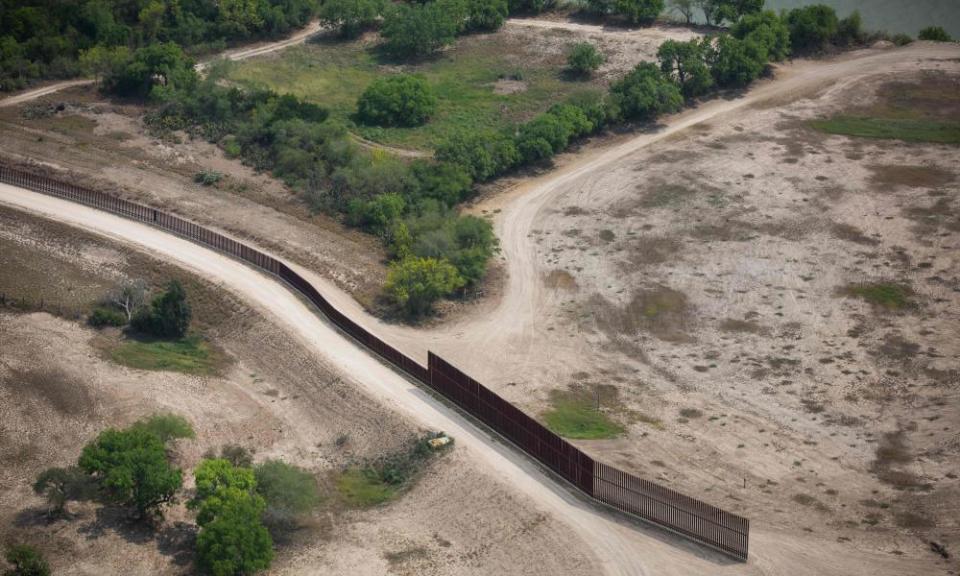Trump's border wall: US military is as unlikely to pay for it as Mexico
A presidential tweet floated the idea of using Pentagon funds to build his dream project but experts say the plan has little chance of success

With his original plan for Mexico to pay for a border wall yet to bear fruit, Donald Trump last week reportedly floated a plan B: the US defense department could foot the bill.
Plan B might be even more of a long shot.
While Trump is known for spitballing ideas – on trade policy, or healthcare, or a joint Russia-US “cybersecurity unit” – he is not known for a mastery of details. And perhaps nowhere are the details so devilish as in the federal budgeting process.
“It’s never going to happen,” said Mark Cancian, an expert in defense spending who ran the force structure and investment division of the office of management and budget (OMB) under Barack Obama. “To fund the wall out of the defense budget, Trump would still have to get the Congress to agree.”
“This is not a man who knows anything about how to actually govern,” said Gordon Adams, who served as associate director for national security and international affairs at the OMB under Bill Clinton. “You’d have to have congressional action to allow the transfer of the funds. And that would require 60 votes in the Senate and that means he’d have to have the Democrats on board.”
Undeterred by any such warnings, if anyone is giving them to him, Trump tweeted what appeared to be a plan for the defense department to cover the cost of the border wall at the weekend.
“Our Military is again rich,” he wrote, a week after signing a budget deal that boosted military spending by tens of billions of dollars. “Building a great Border Wall, with drugs (poison) and enemy combatants pouring into our Country, is all about National Defense. Build WALL through M!”
The White House did not reply to a request for confirmation that “M” stands for the military, not Mexico. A request for comment on the budget strategy behind the president’s suggestion likewise went unanswered.
Trump’s argument that the border wall serves a vital national defense purpose does not change the fact that Congress would have to be involved to “reprogram” the Pentagon dollars, budget experts said.
“They would have to get both the authorization and the appropriation from Congress,” Cancian said. “They could go with what’s called a reprogramming, but then the Congress still has to approve it. No matter how you do it, you have to get both of those pieces, which is why it’s so difficult.”
“It just is really a question of congressional jurisdiction,” said Adams. “Your armed services committees are not going to open the floodgates to general transfers of money out of their jurisdiction to somebody else’s jurisdiction. The defense appropriations committees are no more enthusiastic than the authorizers about giving the executive branch the authority to just will-you nill-you throw money in one direction or another.
“Budgets don’t work that way. You can’t slop money from one purpose of the US code to another title of the US code and just assume everything will blithely walk along.”

Trump approached the House speaker, Paul Ryan, this month about paying for the border wall using military funds, but Ryan was noncommittal, the Washington Post reported.
The financial deal recently agreed by Congress and signed by Trump budgets $700bn for the military in 2018, rising to $716bn next year.
As Trump has publicly lamented, the deal included only $1.6bn for border defense, a fraction of the $25bn Trump had argued for, a figure in line with what the Department of Homeland Security estimates the wall would cost.
To add insult to injury, this $1.6bn is not authorized to be used on the imposing concrete wall prototypes Trump recently viewed in California, since the bill specifies that the money should only be used for 14 miles of “secondary fencing” near San Diego and 25 miles of “primary pedestrian levee fencing” and “primary pedestrian fencing” in the Rio Grande Valley, and is only available for designs “deployed” before this year, “such as currently deployed steel bollard designs”.
In any case, the Department of Homeland Security, which is responsible for border security, and not the defense department, was the logical home for any wall spending, budget experts said.
Trump’s plan has been criticized as a waste of money.
“The problem that he has is political,” said Adams of Trump. “The House and the Senate have made amply clear in the last two legislative sessions that they’re not really interested in dumping $25bn of funding into the president’s wall.”

